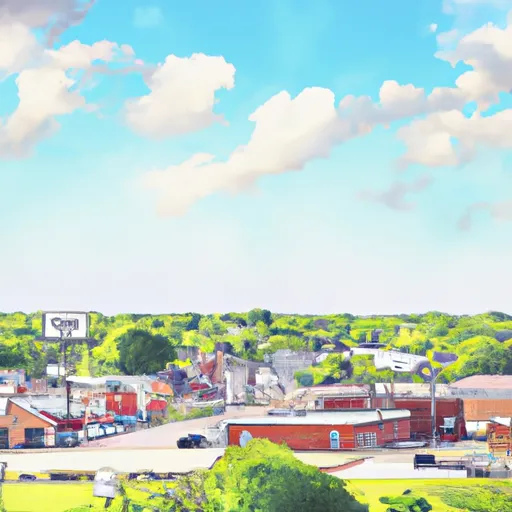-
 Snoflo Premium
Snoflo Premium
Get unlimited access to all our content
With no Ad interruptions! - Start Your Free Trial Login with existing account
Locust-Grove
Eden Index
Climate
8.3
•
Recreation
2.1
•
Community
•
Safeguard
4.0/10

Located in Mayes County, Oklahoma, Locust Grove is a small town with a population of approximately 1,400 residents. The town experiences a humid subtropical climate characterized by hot, humid summers and mild winters. Summers are long and generally see temperatures ranging from the high 80s to the mid-90s Fahrenheit, while winters are mild with temperatures averaging in the mid-40s to low 50s.
Locust Grove is situated near the Grand River, offering residents and visitors various recreational opportunities. The river serves as a habitat for diverse aquatic species and provides opportunities for fishing, boating, and kayaking. Locust Grove Lake, a nearby reservoir, also offers fishing and boating activities.
The hydrology constituents of Locust Grove include the Grand River and several smaller creeks and tributaries. These waterways contribute to the town's natural beauty and provide habitat for wildlife.
In addition to its hydrological features, Locust Grove boasts outdoor recreation opportunities such as camping, hiking, and birdwatching. Nearby natural areas like the Spavinaw Hills, Salina Bay, and Cherokee State Park offer scenic trails and camping facilities, making Locust Grove a destination for nature enthusiasts.
What is the Eden Index?
The Snoflo Eden Index serves as a comprehensive rating system for regions, evaluating their desirability through a holistic assessment of climate health, outdoor recreation opportunities, and natural disaster risk, acknowledging the profound impact of these factors on livability and well-being.
Climate Health Indicator (CHI): 8.3
Locust-Grove receives approximately
1115mm of rain per year,
with humidity levels near 81%
and air temperatures averaging around
16°C.
Locust-Grove has a plant hardyness factor of
7, meaning
plants and agriculture in this region tend to thrive during the non-winter months.
By considering the ideal temperature range, reliable water supplies, clean air, and stable seasonal rain or snowpacks, the Climate Health Indicator (CHI) underscores the significance of a healthy climate as the foundation for quality living.
A healthy climate is paramount for ensuring a high quality of life and livability in a region, fostering both physical well-being and environmental harmony. This can be characterized by ideal temperatures, reliable access to water supplies, clean air, and consistent seasonal rain or snowpacks.
Weather Forecast
Streamflow Conditions
Neosho
Area Rivers
Neosho
Snowpack Depths
Neosho
Reservoir Storage Capacity
Neosho
Groundwater Levels
Recreational Opportunity Index (ROI): 2.1
The Recreational Opportunity Index (ROI) recognizes the value of outdoor recreational options, such as parks, hiking trails, camping sites, and fishing spots, while acknowledging that climate plays a pivotal role in ensuring the comfort and consistency of these experiences.
Access to outdoor recreational opportunities, encompassing activities such as parks, hiking, camping, and fishing, is crucial for overall well-being, and the climate plays a pivotal role in enabling and enhancing these experiences, ensuring that individuals can engage in nature-based activities comfortably and consistently.
Camping Areas
| Campground | Campsites | Reservations | Toilets | Showers | Elevation |
|---|---|---|---|---|---|
| Potato Hills Central | None | 640 ft | |||
| Lost Rapids - Pine Creek Lake | None | 492 ft | |||
| Talimena State Park | None | 1,064 ft | |||
| Pine Creek Cove - Pine Creek Lake | None | 462 ft | |||
| Little River - Pine Creek Lake | None | 537 ft | |||
| Turkey Creek - Pine Creek Lake | 31 | 458 ft | |||
| Lloyd Church Lake | None | 776 ft | |||
| Raymond Gary State Park | None | 480 ft | |||
| Clayton Lake State Park | None | 738 ft | |||
| Virgil Point - Hugo Lake | None | 452 ft |
Nearby Fishing
Catastrophe Safeguard Index (CSI):
The Catastrophe Safeguard Index (CSI) recognizes that natural disaster risk, encompassing floods, fires, hurricanes, and tornadoes, can drastically affect safety and the overall appeal of an area.
The level of natural disaster risk in a region significantly affects safety and the overall livability, with climate change amplifying these risks by potentially increasing the frequency and intensity of events like floods, fires, hurricanes, and tornadoes, thereby posing substantial challenges to community resilience and well-being.
Community Resilience Indicator (CRI):
The Community Resilience Indicator (CRI) recognizes that education, healthcare, and socioeconomics are crucial to the well-being of a region. The CRI acknowledges the profound impact of these elements on residents' overall quality of life. By evaluating educational resources, healthcare accessibility, and economic inclusivity, the index captures the essential aspects that contribute to a thriving community, fostering resident satisfaction, equity, and social cohesion.

